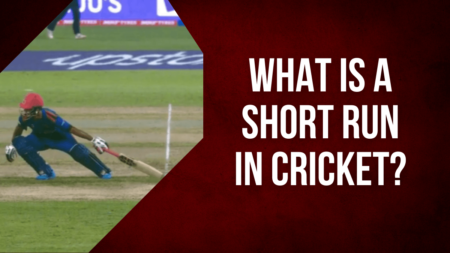

The cricket pitch has two ends. On each end is a crease drawn. This crease serves many purposes. The batsman facing the bowler is called the strike batsman. This batsman can choose to be inside or outside the crease. However, at the other end or the non-strike end, the batsman must be inside the crease.
In cricket, runs are scored from the batsman’s bat in three ways:
- Hitting the bowl in a way that it directly crosses the boundary (6 runs awarded)
- Hitting a bowl in a way that it pitches at least once before crossing the boundary (4 runs awarded)
- Hitting a bowl and later changing ends on the pitch by landing the bat within the crease (1 run awarded for each time the batsman exchange ends)
The third point can naturally arise one question in a reader’s mind- How many such runs can a batsman score by simply running between the wickets?
According to the laws, there is no rule that states that batsmen cannot run more than a certain number of times. By logic, batsmen run until the fielder gets hold of the ball and throws it back to the fielder standing near the stumps. This is because if the batsman fail to reach the crease before the fielders dislodge the stumps, they would be deemed run out.
Running between the wickets to score runs is the most common method of scoring runs. Batsmen regularly exchange ends once or twice in one ball to score a single (1 run) or a double (2 runs). Running three runs is uncommon but has taken place. Running four runs is even more rare but instances have take place.
Batsmen can certainly run 5 runs. But this has never occurred as a result of a shot that was hit and later returned by the fielder to the wicket-keeper. This is were “overthrow” comes into picture. Let us say a fielder throws the ball and aims to direct it at the fielder near the stumps. However, he misfires and the ball travels beyond the pitch in the opposite direction. This means the ball is still in play. The batsmen can still change ends until another fielder picks up the overthrown ball and throws is back to the fielder near the stumps.
Let us say that in a rare case the batsmen exchanged their ends by running between the wickets three times. The fielder collects the ball but misdirects it to the fielder near the stumps such that it results in an overthrow. The batsman take the opportunity and run two more runs till the fielder collects the ball and directs it back at the stumps. This is how a batsman score five runs by simply running between the wickets. The breakdown of 3 runs plus 2 overthrown runs can also be calculated in a 4+1, 2+3 and 1+4 fashion.
Thus, a batsman can score five runs and if luck persists even more runs by simply running between the wickets.




